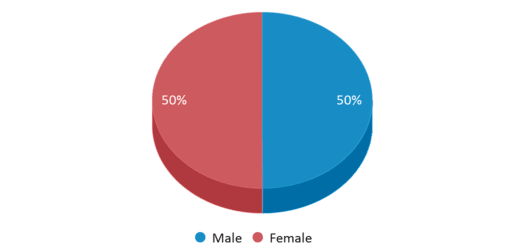Serving 2,163 students in grades 10-12, Auburn High School ranks in the top 20% of all schools in Alabama for overall test scores (math proficiency is top 10%, and reading proficiency is top 10%).
The percentage of students achieving proficiency in math is 52% (which is higher than the Alabama state average of 29%). The percentage of students achieving proficiency in reading/language arts is 53% (which is higher than the Alabama state average of 47%).
The student:teacher ratio of 17:1 is equal to the Alabama state level of 17:1.
Minority enrollment is 42% of the student body (majority Black), which is lower than the Alabama state average of 49% (majority Black).
Quick Stats (2025)
- Grades: 10-12
- Enrollment: 2,163 students
- Student:Teacher Ratio: 17:1
- Minority Enrollment: 42%
- Graduation Rate: 95% (Top 20% in AL)
- Overall Testing Rank: Top 20%
- Math Proficiency: 52% (Top 10%)
- Reading Proficiency: 53% (Top 50%)
- Science Proficiency: 56% (Top 20%)
- Source: National Center for Education Statistics (NCES), AL Dept. of Education
Top Rankings
Auburn High School ranks among the top 20% of public schools in Alabama for:
Category
Attribute
Overall Rank
Math Proficiency
Science Proficiency
Graduation Rate
School Overview
Auburn High School's student population of 2,163 students has grown by 15% over five school years.
The teacher population of 125 teachers has grown by 9% over five school years.
Grades Offered
Grades 10-12
Total Students
2,163 students

Gender %

Total Classroom Teachers
125 teachers

Students by Grade

School Rankings
Auburn High School ranks within the top 20% of all 1,285 schools in Alabama (based off of combined math and reading proficiency testing data).
The diversity score of Auburn High School is 0.60, which is less than the diversity score at state average of 0.63. The school's diversity has stayed relatively flat over five school years.
Overall Testing Rank
#243 out of 1285 schools
(Top 20%)
(Top 20%)

Math Test Scores (% Proficient)
52%
29%

Reading/Language Arts Test Scores (% Proficient)
53%
47%

Science Test Scores (% Proficient)
56%
38%

Student : Teacher Ratio
17:1
17:1

American Indian
n/a
1%
Asian
11%
1%

Hispanic
7%
11%

Black
22%
32%

White
58%
51%

Hawaiian
n/a
n/a
Two or more races
2%
4%

All Ethnic Groups



Graduation Rate
95%
88%

Participates in the National School Lunch Program (NSLP)
Yes
Eligible for Free Lunch
28%
56%

Eligible for Reduced Lunch
3%
5%

School Statewide Testing
School District Name
Source: National Center for Education Statistics (NCES), AL Dept. of Education
School Notes
- Auburn High School is a public high school in Auburn, Alabama, enrolling students in grades 10-12. It is the only high school in the Auburn City School District. Auburn High offers technical, academic, and International Baccalaureate programs, as well as joint enrollment with Southern Union State Community College and Auburn University. Founded in 1837 in a log church on the Alabama frontier, Auburn High has grown into an elite center of secondary learning recognized as one of the top public high schools in the United States.
- Academics: Auburn High School is a comprehensive secondary school along the classic American model. As such, Auburn High offers a diverse curriculum including traditional high school academic subjects, advanced academic classes, music and art, and programs in business and marketing, agriscience, industrial systems technology, and engineering. All students at Auburn High take a basic academic core including English, Social Studies, Science, and Math courses. A broad selection of elective courses are offered, and students may elect to major in one of four areas: Arts and Humanities, Business and Marketing, Engineering and Industrial Systems Technology, and Health and Human Services. Majors are offered in Graphic Design, Instrumental Performance, Vocal Performance, Theatre, Photography, Art, Business Administration, Accounting, Communications, Construction, International Studies, Industrial Systems Technology, Agriscience, Pre-Engineering, Military Science, and Health Science.
- Auburn High School awards three diploma endorsements indicating advanced study in a particular field, as well as the International Baccalaureate Diploma. Auburn High offers nearly 30 college-level Advanced Placement, Technical Advanced Placement, and International Baccalaureate courses for college credit. Students are also provided access to college courses at nearby Auburn University and Southern Union State Community College.
- Classes at Auburn High are arranged in a unique combination block/alternating day schedule in which four 90 minute classes are offered each day. Some classes meet every day for one semester, while others alternate every other day for the whole year.
- Achievements and accolades: Auburn High was ranked the 77th best public high school overall and 28th best non-magnet public high school in the nation by Newsweek in May 2006, one of the top 100 public high schools in the nation by the Associated Press based on Advanced Placement test scores, the 125th best public high school in the United States by the US News and World Report and the second best educational value in the Southeast by SchoolMatch, as reported in the Wall Street Journal.
- Some 90% of Auburn High graduates go on to post-secondary education, with on average 5% of the senior class earning National Merit Finalist or National Achievement Finalist status. A full quarter of AHS graduates receive academic scholarships to colleges and universities ranging from local schools such as Auburn University and Georgia Tech to national schools such as Duke, Rice, Chicago, Vanderbilt, and the University of Virginia. In 2006, seventy-eight seniors received 167 scholarships worth $4.2 million to 68 different colleges in 27 states. Recent AHS graduates attend MIT, Princeton, Harvard, Columbia, the University of Pennsylvania, and Yale.
- History: Auburn High was originally started as a frontier school in 1837, less than three years after the Auburn area had been opened to settlement. A two-story frame school building was constructed in 1838, and in the early 1840s a separate male academy had been spun off of the school. With the school for males solidly established, and most of the secondary students now being female, in 1843 the school was named the Auburn Female College.
- The Auburn Female College attracted hundreds of boarding students to Auburn in the 1840s and 1850s, from as far as Lowndes County and Georgia, largely in part of it offering a complete secondary education to women (including ancient and modern languages, literature, mathematics, and musical arts) at the same academic level of that given to men. The school was rechartered as a Mason school in 1852, becoming the Auburn Masonic Female College.
- Throughout the 1850s, the school flourished. The school physical plant was expanded to include a chapel with the largest auditorium in eastern Alabama and a fully equipped chemistry laboratory. Faculty members included John M. Darby, a scientist who wrote his own textbooks for his students, including a Textbook of Chemistry and Botany of the Southern States, which was the earliest compilation of flora in the South, and William P. Harrison a Methodist theologan who was eventually appointed Chaplain of the United States House of Representatives. The school was especially strong in language offerings, with students in 1861 able to take classes in Greek, Latin, French, Spanish, German, and Italian. The Auburn Masonic Female College also hosted speakers and debates among some of the era's greatest luminaries, most notably an 1860 debate over secession which included William Lowndes Yancey, Alexander Stephens, Benjamin Harvey Hill, and Robert Toombs.
- The Masons relinquished control back to the community in the late 1850s, returning the name to Auburn Female College. By the early 1860s, the school began admitting boys to the secondary division.
- When the Civil War began in 1861, virtually the entire male junior and senior classes of the school, as well as much of the faculty joined Confederate military units, particularly, the 37th Alabama Regiment. As the "principal teacher", W.F. Slaton, was also a major in the regiment, classes in Auburn stopped for the remainder of the war. The regiment was captured at Corinth, Mississippi, and exiled to the Johnson's Island prisoner of war camp in Lake Erie. While imprisoned there, Slaton held the school's classes in the camp. Notably, the African American Union guards, who were prohibited by law from attending school in their native Wisconsin, were invited to join the classes, making Auburn High one of the first Southern schools to integrate, some 90 years before Brown v. Board.
- Upon the end of the war, students and teachers returned back to Auburn, but economic hardships in the aftermath of the war and Reconstruction left Auburn High closed for several years. In the late 1860s, the school reopened in the building formerly occupied by the male academy, though with substantially lower enrollment than the two decades prior.
- The next few decades were difficult ones for the school. State funding was practically non-existent until the late 1870s, and the town's economic condition was poor, making it difficult to support the school. Whereas, prior to the war in 1855, the secondary division enrolled 110 students, in 1889 "Auburn High School"--by then, the school's official name--enrolled fewer than 20.
- In 1892, Auburn University (then the Alabama Agricultural and Mechanical College) decided to admit women. However, since the college only admitted women with junior standing, Auburn High added two more years of classes beyond the secondary level (equivalent to freshman and sophomore college classes) for women. With this addition, the name of the school was changed to the Auburn Female Institute.
- In 1899, a new, two-story school was built for Auburn High. In 1908, the school dropped the post-secondary program and became "Auburn High School" once more. Around 1910, Auburn High fielded its first basketball team, and by 1915, its first football squad. In 1914, Auburn High became the flagship high school for the county and was officially renamed Lee County High School as well as moving into a new building.
- In the period between 1910 and 1920, Auburn High changed from an academy of the classic 19th century model, focusing on philosophy and ancient languages, to a comprehensive high school offering vocational and technical courses in addition to the academic offerings. In 1925, Auburn High became one of the first high schools in the state to be accredited by the Southern Association of Colleges and Schools. Over the next two decades, Auburn High developed its modern extracurricular face, forming band, choir, and other programs, as well as diversifying occupational classes. A new school building was constructed in 1931, and in 1956, the school was officially renamed Auburn High School again.
- In 1961, the City of Auburn created its own school system, with Auburn High as the new district's sole high school. In 1966, the school moved to the current campus, organized as a "Freedom of Choice" school designed to promote desegregation. In 1971, Auburn High merged with nearby Drake High to complete its integration.
- The last three decades have been marked with rapid growth of the school. Five major additions have been made to Auburn High since the original construction in 1966, and in 2004 the school was changed from housing grades 9-12 to housing grades 10-12.
- Extracurricular organizations: Auburn High School offers a full slate of academic clubs, athletic teams, and service organizations. Offerings include A Club; Advocacy Club; Anchor Club; Anime Society; BEST Robotics; Color Guard/Honor Guard; DECA (Organization); Diamond Dolls; Drill Team; English Honor Society; Environmental Club; Family, Career, Community Leaders of America; Fellowship of Christian Athletes; Film Appreciation Society; French Club; French Honor Society; Future Business Leaders of America; Future Farmers of America; Future Teachers of America; German Club; German Honor Society; Government Club; Interact Club; Judicial Club; Junior Civitan; Key Club; Math Team; Mu Alpha Theta; Multicultural Club; National Art Honor Society; National Honor Society; Pep Club; Raider Team; Rifle Team; Scholars' Bowl; Science Club; Science Olympiad; Skills USA; Spanish Club; Spanish Honor Society; Student Council; Student Outreach for Christ; The Sheet; Theatre Center Stage; and Tiger Ambassadors.
- Athletics: Auburn High School offers 11 men's and 10 women's varsity sports, all in the large school (6A) classification of the Alabama High School Athletic Association (AHSAA). Auburn High has one of the strongest overall athletic programs in the state, having placed in the top ten of the 6A All-Sports rankings every year since 1995, and ranking in the top four for the 2004-2005 and 2005-2006 school years. Auburn High has won a total of 32 state championships since recordkeeping begain in the 1950s. Auburn High traditionally has powerhouse programs in men's basketball, men's and women's track, men's golf, men's and women's tennis, and men's and women's soccer.
- Football: Auburn High's football team competes in Region 3 of class 6A along with Central High of Phenix City, Dothan, Enterprise, Northview High of Dothan, Opelika, Russell County, and Smith's Station. Auburn High has become somewhat of a pipeline to the NFL--since 2004, no high school has produced more All-Pro NFL players than Auburn High. AHS alumni in the NFL include Marcus Washington of the Washington Redskins, Osi Umenyiora of the New York Giants, and Demarcus Ware of the Dallas Cowboys.
- Auburn High's football team has a long history, dating back to 1915, with traditional rivalries against Opelika, Central, Benjamin Russell, and Valley High Schools. The Auburn High football squad has finished the season unbeaten on six occasions (1923, 1925, 1926, 1927, 1934, and 1952), all prior to the establishment of statewide playoffs. Auburn High has once been ranked first in the state (October 1967), and proceeded deepest into the playoffs in 2001, when the team reached the semifinal round.
- Auburn High plays at 10,000 seat Duck Samford Stadium.
- Basketball: Auburn High's men's basketball team has a rich tradition as a powerhouse program. Auburn High won the 6A state championship in 2005, and was state runner-up in 1924, 1987, 1991, and 1996. The team is coached by 24-year veteran Frank Tolbert, who has amassed a 535-241 record.
- Auburn High plays at the 1,500 seat Auburn Fieldhouse on the Auburn High campus.
- Golf: Auburn High's men's golf program has in recent years become one of the school's strongest sports. AHS has won each of the three last 6A championships (2004, 2005, 2006), and returns the nucleus of the 2006 squad for 2007. AHS girls' golf has also been strong, having placed in the top five in the state twice in the last five years.
- Auburn High's official home course is Indian Pines Golf Course, though the Auburn University Club and Robert Trent Jones' Grand National are often used as home courses.
- Track and field: Traditionally Auburn High's most laureled sport, Auburn High's six track family sports--men's and women's outdoor track, men's and women's indoor track, and men's and women's cross country--have amassed twenty state championships. AHS men's outdoor track squad has won seven seven AHSAA titles and has placed in the top 10 at the state track meet each of the last five years. AHS women's outdoor team won a state title in 1986, and has also placed in the top 10 at state each of the last five years. Men's indoor track has won four state titles, and men's cross country has won the state crown six times. Prior to the creation of the AHSAA, Auburn High won the Alabama Interscholastic Track and Field Meet in 1921 and 1923.
- Swimming and diving: Auburn High has always had a competitive swimming program, with a particular strength in developing divers. AHS divers have won nine state championships since 1988, and have helped the Lady Tigers to four top five finishes in the last five years at the state meet.
- Auburn swims at the James E. Martin Aquatic Center.
- Band: The Auburn High School Band is considered by many to be one of the top high school concert bands in the United States. The AHS Band was awarded the Sudler Flag of Honor by the John Philip Sousa Foundation as the top high school concert ensemble in the United States, Canada, and Japan in 1988. The Auburn High Band has also been placed on the "Historic Roll of Honor of Distinguished High School Concert Bands in America" as a band which as attained "unusual levels of achievement nationally and which [is] considered to be of historical importance and influence to the nation's high school concert band programs." The concert band has an all-time ratings record of 330-4-0-0-0, and has received less than a perfect rating only three times since 1946, and has received perfect ratings in from all judges since 1974. The Band has twice performed for the Music Educators National Conference, and in 1996 became the first high school band ever invited to perform for a College Band Directors National Association Conference.
- Auburn High School's jazz ensemble, the Lab Band, has received similar honors. The Lab Band was named one of the top ten high school jazz bands in the United States in 1974, and in 1978 performed on the National Association of Jazz Educators "Project II" album as one of "The Nation's Most Outstanding Jazz Bands". Since then, the Lab Band has an all-judges record of 126-2-0-0-0, and has performed at the Montreux Jazz Festival in Switzerland.
- Science Olympiad: The Auburn High School Science Olympiad team has been the dominant team in Alabama over the past two decades. Auburn's Science Olympiad team has placed either first or second in the state 18 out of the past 21 years, with participants winning hundreds of gold, silver, and bronze medals.
- Campus: Auburn High is situated on 42 acres (0.18 km²) in the east-central part of Auburn. The school is designed in a campus-style setting, with nine detached buildings separated by outdoor walkways and courtyards spread out over 70% of the campus area. The campus contains academic classrooms, auditorium, competition gym (the Auburn Fieldhouse), tennis courts, a baseball field (Sam Welborn Field), a track, cafeteria, library, multi-media room, small auditorium, practice gym, and physical education fields. Off-campus athletic facilities include Duck Samford Stadium, the Auburn Softball Complex, and the James E. Martin Aquatic Center.
- Technology: Auburn High School is in the initial stages of the Auburn City Schools' 21st Century Technology Initiative. As part of this initiative, every classroom will be equipped with a digital smartboard, and the entire campus will be covered by a wireless network. Starting in the 2007-2008 school year, every student at Auburn High will be provided with a laptop computer which will be theirs to use both in school and at home. The initiative also provides considerable training for teachers in integrating this technology into instruction.
- Student body: Due in part to its proximity to a major research university, Auburn High School has a relatively diverse student body for the area.
- Traditions - Mascot: Auburn High's mascot is the tiger. The tiger was chosen because of its association with Auburn in Oliver Goldsmith's 1770 poem The Deserted Village. The first line of the poem is "Sweet Auburn! Loveliest village of the plain", while a later line describes Auburn as, "where crouching tigers wait their hapless prey."
- Auburn High's costumed mascot is Samford, an anthropomorphic tiger. Samford was created in 1995 and named for three symbols of the school--Samford Avenue, which runs by the school; Duck Samford Stadium, Auburn High's football stadium; and Samford Hall, the most prominent building in Auburn. Kari Pierce was the first Samford in 1995.
- Notable alumni: William J. Samford (1864) - Governor of Alabama; William Spratling (1917) - Silversmith and artist; Joe Beckwith (1973) - Major League Baseball pitcher; Ted Vives (1982) - Composer; Man or Astro-man? (1980s) - Surf punk band; William Chen (1988) - Winner in 2 2006 World Series of Poker events; Ace Atkins (1989) - Author, Pulitzer Prize-nominated journalist; James Fukai (1992) - Guitarist, Trust Company; Mark Spencer (1995) - President/CEO, Digium, creator of Asterisk PBX; Marcus Washington (1996) - NFL football player; Osi Umenyiora (1999) - NFL football player; Demarcus Ware (2001) - NFL football player.
Profile last updated: 02/09/2025
Frequently Asked Questions
What is Auburn High School's ranking?
Auburn High School is ranked #243 out of 1,285 schools, which ranks it among the top 20% of public schools in Alabama.
What schools are Auburn High School often compared to?
Auburn High Schoolis often viewed alongside schools like Opelika High School by visitors of our site.
What percent of students have achieved state testing proficiency in math and reading?
52% of students have achieved math proficiency (compared to the 29% AL state average), while 53% of students have achieved reading proficiency (compared to the 47% AL state average).
What is the graduation rate of Auburn High School?
The graduation rate of Auburn High School is 95%, which is higher than the Alabama state average of 88%.
How many students attend Auburn High School?
2,163 students attend Auburn High School.
What is the racial composition of the student body?
58% of Auburn High School students are White, 22% of students are Black, 11% of students are Asian, 7% of students are Hispanic, and 2% of students are Two or more races.
What is the student:teacher ratio of Auburn High School?
Auburn High School has a student ration of 17:1, which is equal to the Alabama state average of 17:1.
What grades does Auburn High School offer ?
Auburn High School offers enrollment in grades 10-12
What school district is Auburn High School part of?
Auburn High School is part of Auburn City School District.
School Calendar
View the Auburn High School yearly calendar below. Note key dates such as:
Event
Date
Seniors Last Day
May 14, 2025 (Wednesday)
School Reviews
Review Auburn High School. Reviews should be a few sentences in length. Please include any comments on:
- Quality of academic programs, teachers, and facilities
- Availability of music, art, sports and other extracurricular activities
Recent Articles

What Is A Charter School?
Explore the world of charter schools in this comprehensive guide. Learn about their history, how they operate, and the pros and cons of this educational innovation. Discover key facts about charter schools, including admission policies, demographics, and funding, as well as what to look for when considering a charter school for your child.

10 Reasons Why High School Sports Benefit Students
Discover the 10 compelling reasons why high school sports are beneficial for students. This comprehensive article explores how athletics enhance academic performance, foster personal growth, and develop crucial life skills. From improved fitness and time management to leadership development and community representation, learn why participating in high school sports can be a game-changer for students' overall success and well-being.

February 05, 2025
Understanding the U.S. Department of Education: Structure, Impact, and EvolutionWe explore how the Department of Education shapes American education, from its cabinet-level leadership to its impact on millions of students, written for general audiences seeking clarity on this vital institution.





